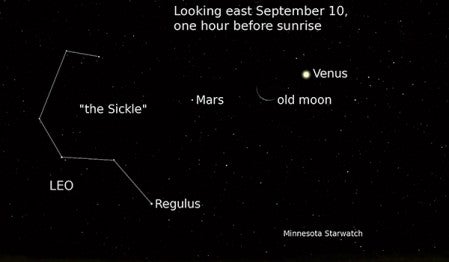Autumn stars alight
Published 5:01 pm Saturday, August 29, 2015
By Deane Morrison
University of Minnesota
The autumn stars are moving in, and so is autumn itself. But September has only one big story this year: the moon.
A warm-up to the show happens the morning of the 10th, when a waning crescent moon appears in the east between bright Venus and subdued Mars. Look about an hour before sunrise; with sharp eyes or binoculars, you may also find Regulus, the brightest star in Leo, rising below Mars.
 And speaking of Regulus, look to the east about an hour before sunrise on the 25th. Venus will be fairly high, Jupiter fairly low, and midway between them you’ll see Mars (left) and Regulus, only 0.8 degrees apart. Binoculars will make it easier to compare Mars’ soft red glow with the blue-white of Regulus.
And speaking of Regulus, look to the east about an hour before sunrise on the 25th. Venus will be fairly high, Jupiter fairly low, and midway between them you’ll see Mars (left) and Regulus, only 0.8 degrees apart. Binoculars will make it easier to compare Mars’ soft red glow with the blue-white of Regulus.
The big show rolls into the sky with September’s full moon, which rises the evening of the 27th and proceeds to churn up a perfect storm of delights. Coming just four days after the equinox, it is the harvest moon. It rises only about three hours before achieving fullness, so it will be quite round. It is the closest, and therefore biggest-looking, full moon of the year. Finally, still on the evening of the 27th, it undergoes a total eclipse, with totality lasting from 9:11 to 10:23 p.m.
The harvest moon reaches perigee, the closest approach to the Earth in its orbit, at 8:46 p.m., when it will be about 221,750 miles away—more than 17,000 miles closer than its average distance. It becomes full at 9:50 p.m., but by then it will be engulfed in Earth’s shadow, deep into totality. If we’re lucky, Earth’s sunrises and sunsets will refract lots of red light onto the moon’s face and turn it into a celestial pumpkin.
The moon will have companions on its big night. Above it sails the Great Square of Pegasus, the winged horse of mythology. Closer but fainter is the Circlet of Pisces, which is easy to find right below the Great Square. Moving southwest from the Circlet, look for the Y-shaped Water Jar of Aquarius and its spidery constellation, and then the chevron-shaped Capricornus, the sea goat. Some of these stars may be washed out by the full moon, but as it plows through Earth’s umbra, or deep inner shadow, its glare lessens and the stars brighten around it. Let’s hope the night isn’t cloudy, because we don’t get another total lunar eclipse until January 31, 2018.
The fall equinox arrives at 3:21 a.m. on the 23rd. At that moment the sun crosses the equator into the southern sky, and the Earth is lighted from pole to pole.
Proximity to the autumnal equinox makes a fullish moon rise relatively earlier from night to night. It behaves this way because the full moon is opposite the sun in the sky. This means it is moving most rapidly north as the sun is dropping most rapidly, as it does near the fall equinox. This causes the moon to rise earlier than it otherwise would over a few nights close to full phase, just as the sun rises earlier every day in the spring. The shorter wait for moonlight is a gift to farmers working late to harvest their crops.
The University of Minnesota offers public viewings of the night sky at its Duluth and Twin Cities campuses. For more information and viewing schedules, see:
Duluth, Marshall W. Alworth Planetarium: www.d.umn.edu/planet
Twin Cities, Minnesota Institute for Astrophysics (during fall and spring semesters): www.astro.umn.edu/outreach/pubnight.
Check out the astronomy programs at the University of Minnesota’s Bell Museum ExploraDome: www.bellmuseum.umn.edu/ForGroups/ExploraDome/index.htm.
Contact: Deane Morrison, University Relations, (612) 624-2346,morri029@umn.edu
Find U of M astronomers and links to the world of astronomy athttp://www.astro.umn.edu.

